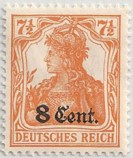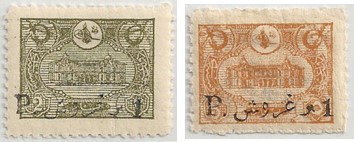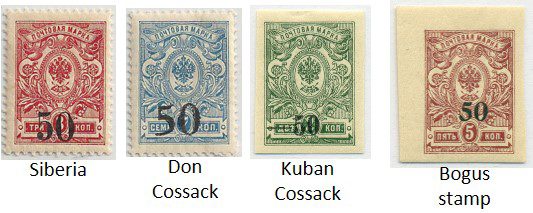Issue #7
Apr 11, 2018
Michael Adkins
Welcome to Issue 7 of the DCStamps Investigator. If you are a regular reader, you might have noticed that it has been issued at a slower pace than anticipated. This is primarily because I am diligently working in the background to improve DCStamps. It is a large task, as it involves updating and modernizing all of the more than 130 articles and 200 albums posted on the site. Plus, I am working on several new transition charts for areas such as Morocco/Western Sahara and some of the areas in the Balkans. Please be patient, as it is a daunting task for an individual.
Surcharges and Overprints
In the last issue of the Investigator, we covered dead country stamps that can be identified by symbols overprinted on the stamp. In this issue, we will cover a different area, which can sometimes be quite difficult to properly identify — surcharges.
An overprint is the general term used for an additional marking that is applied to stamps after they have been printed. If the overprint changes the value or currency of the stamp, then it is called a surcharge. Generally, surcharges come in three different categories:
- Change in value. This is when a new value is attributed to the stamp, usually to cover shortages or to reflect changes in postal rates.
- Change in currency. There are situations where a change in currency is required to be applied to a stamp. Probably the most common situation is when a country is being occupied by a foreign power. Often stamps of the occupier are used to control postage, but require them to be sold using the currency of the occupied country. This can be seen in the first example in this article.
- Additional charge added. Often called a semi-postal or charity stamp, additional charges are supercharged to the stamp as an additional tax.
Surcharges on Dead Country Stamps
Of course, most overprints and surcharges do not indicate a different country. They were applied as a quick, less expensive way to rapidly reflect shortages of a denomination or changes in postal rates. This was especially true in far flung colonies, where new stamps would often take months to be shipped to the country.
However, for many “new” countries created during times of war or revolution, applying overprints and surcharges to existing stocks of stamps, was a quick way of getting a postal system up and running. And many times, those overprinted or surcharged stamps were the only stamps issued by the entity. This can often be maddening for collectors, as sometimes only a number was surcharged to the stamp, and to make it even more difficult, it takes an understanding of the size and font of the print to properly identify the issuing entity of the stamps.
Here are a few examples:
German Occupation along the Western Front in WW1
 On Aug 4th, 1914, at the onset of World War 1, Germany invaded and occupied Belgium along with the northern portion of France. The goal was to use this region as a staging area to conquer France and ultimately the UK. The Allies stopped the German advance resulting in a standoff between the two entrenched armies from 1914 – 1918. The line between the two forces is commonly called the “Western Front.”
On Aug 4th, 1914, at the onset of World War 1, Germany invaded and occupied Belgium along with the northern portion of France. The goal was to use this region as a staging area to conquer France and ultimately the UK. The Allies stopped the German advance resulting in a standoff between the two entrenched armies from 1914 – 1918. The line between the two forces is commonly called the “Western Front.”
For much of the occupation, stamps of Germany were overprinted “Belgien” and surcharged in Belgian Francs for use in the occupied area. In 1916, the Germans issued stamps with only a surcharge — also in Belgian Francs, primarily for use in Flemish areas of Belgium and France. The Michel catalog calls the region the “Etappengebiest West” which loosely translates Western Staging Areas. Scott catalogs this under German Occupation of France, which is somewhat misleading. They were issued on Dec 1, 1916 and were in use until May, 1917.
Autonomous Western Thrace
 One might think that a surcharge in Turkish currency on a stamp of the Ottoman Empire would be simple. However, it would be a struggle to find these issues listed under Turkey in the catalogs. They were actually issued by the short lived Autonomous Government of Western Thrace.
One might think that a surcharge in Turkish currency on a stamp of the Ottoman Empire would be simple. However, it would be a struggle to find these issues listed under Turkey in the catalogs. They were actually issued by the short lived Autonomous Government of Western Thrace.
During the First Balkan War (1912-1913), Serbia, Greece, Bulgaria and Montenegro fought the Ottoman Empire, driving them from most of their European territory. Afterwards, when the land was divided, Bulgaria was unhappy with its portion. As a result, Bulgaria launched an attack on its former allies in June 1913, starting the Second Balkan war. The attacks were driven back and Greek and Serbian armies invaded Bulgarian-held territory in return. At the same time, the Ottomans advanced into Eastern Thrace, and Romania used the opportunity to invade Bulgaria from the north. Isolated and surrounded by a more powerful coalition of opponents, Bulgaria was forced to agree to a truce and to peace negotiations. As a result, Bulgaria ended up with little additional territory from the first Balkan War, mostly in Western Thrace.
Unhappy with this agreement, the Turks in Gumulcine and Iskece, in Western Thrace, rose up in revolt on Aug 31, 1913. The “revolutionaries” declared the formation of the Provisional Government of Western Thrace, and on Sept 25th, declared their independence by renaming it the Independent Government of Western Thrace. However, once Bulgaria signed an agreement with the Ottomans regarding the borders, and the Ottomans withdrew, Bulgarian troops entered Western Thrace. The Autonomous government was ended in late October, 1913. During the revolution, the Turks of Western Thrace issued stamps for use in the areas they controlled.
Surcharges in the Russian Civil War
 Probably some of the more complicated surcharges to identify came from the chaos of the the Russian Civil War. After the fall of the monarchy and the October Revolution (Nov, 1917), a bloody civil war erupted in Russia. The Bolsheviks (often called the Red Army), created a new state called the Russian Socialist Federal Soviet Republic (RSFSR). In opposition, the loyalist armies (often called the White Army) generally wanted to reinstate the monarchy.
Probably some of the more complicated surcharges to identify came from the chaos of the the Russian Civil War. After the fall of the monarchy and the October Revolution (Nov, 1917), a bloody civil war erupted in Russia. The Bolsheviks (often called the Red Army), created a new state called the Russian Socialist Federal Soviet Republic (RSFSR). In opposition, the loyalist armies (often called the White Army) generally wanted to reinstate the monarchy.
The RSFSR, printed their own stamps, usually with revolutionary themes. However the fractured White Armies took the readily available imperial stamps and surcharged them in Russian Rubles, due to rampant inflation caused by the war. These surcharged stamps are often the only ones issued by a particular entity. In the images above, I have shown four examples of stamps surcharged 50 Russian Rubles during this period. They can only be distinguished by the font and size of the numerals.
The first is from the Provisional All-Russian Government under Admiral Aleksandr Kolchak. In 1918, Kolchak declared his government to be the legitimate anti-Bolshivik government of Russia. The Provisional government was headquartered in Omsk, a city in Western Siberia. Kolshak also had the gold reserves of the former Russian Empire, as well as the support of the Allies in the civil war. However, one of the firsts objectives of the superior Red Army was to take Omsk and possession gold reserves. In Nov 1919, they took the city and the reserves, and eventually captured and executed Kolchak on Feb 7, 1920. The stamps issued by the Kolchak government can be found under Siberia in catalogs.
The next two examples are found under “South Russia” in Scott and Stanley Gibbons. The Cossacks, fierce fighters and strong supporters of the Czar, where natural allies of the the White Armies. After the Bolshevik revolution, the Don Cossack host declared its independence and the formation of the Don Republic in 1918, Don territory bordered much of Ukraine, who were their natural allies. The third surcharge was issued by the Kuban Cossack host, lying south of the Don on the eastern shores of the Black sea. The Kubans were more fractured than the Don, with groups supporting both sides. Ultimately the Red supporters were ejected from Kuban territory. Both Cossack Hosts were part of General Denkins White Army of South Russia. The White Army was ultimately defeated by the Bolshiviks in 1920, and afterwards, the Soviets instituted the brutal “decossackization” (Raskazachivaniye), a major program of genocide and exile.
To make matters more complicated, there were also bogus stamps issued during the civil war, such as the one that is similar to the Kuban issue, but without the dash.
The Next Issue of the Investigator
In the next issue, we will finish our series on overprints, discussing some of the more confusing and misleading examples. Until then, your comments and questions are most welcome.
Also, as indicated at the beginning, I am working at modifying the format of the dead country articles — so if you have any suggestions, please let me know.
Until then
W. Michael Adkins






Very interesting Michael, thanks for doing this and for sharing. Overprints are a very fascinating part of philately!
Hi Jon
I agree, very interesting, except of course for the proliferation of the dark underbelly of philately — counterfeits.
I enjoyed this talk of surcharges and overprints in dead countries. The craziest one I saw was the Vasco de Gamma Portuguese colonial issue as being done by Inhambane, the area of Mozambique. The stamp was being sold so long that it had separate overprints relating to Portugal becoming a republic and a change in currency. By the time all that had happened the original anniversary of de Gamma’s voyage was more than a decade in the past.
Hi John
Sometimes they really are crazy. In fact, several of the Mozambique colonial provinces of the era issued those surcharged overprints on Da Gama stamps, such as Tete and Quelimane. In reality, I don’t think Portugal supported much of their Mozambique province, as major areas were given over to corporate interests – Mozambique Company and Nyassa Company.
Michael
Thanks Michael. I learnt a lot that I didn´t know about surcharges by reading your articles. I wonder where you get all this information. Best regards.
Gracias Jorge
Welcome to DCStamps, and I appreciate your kind words. All of the info is readily available in catalogs and other experts online. I just enjoy doing the research and presenting it from a different angle.
Michael